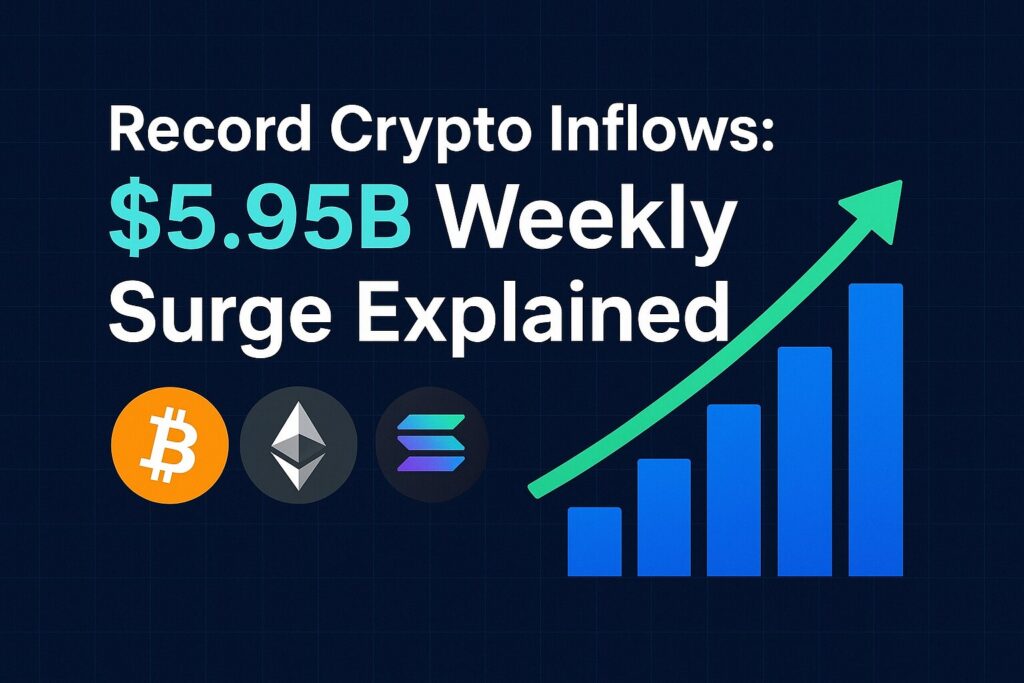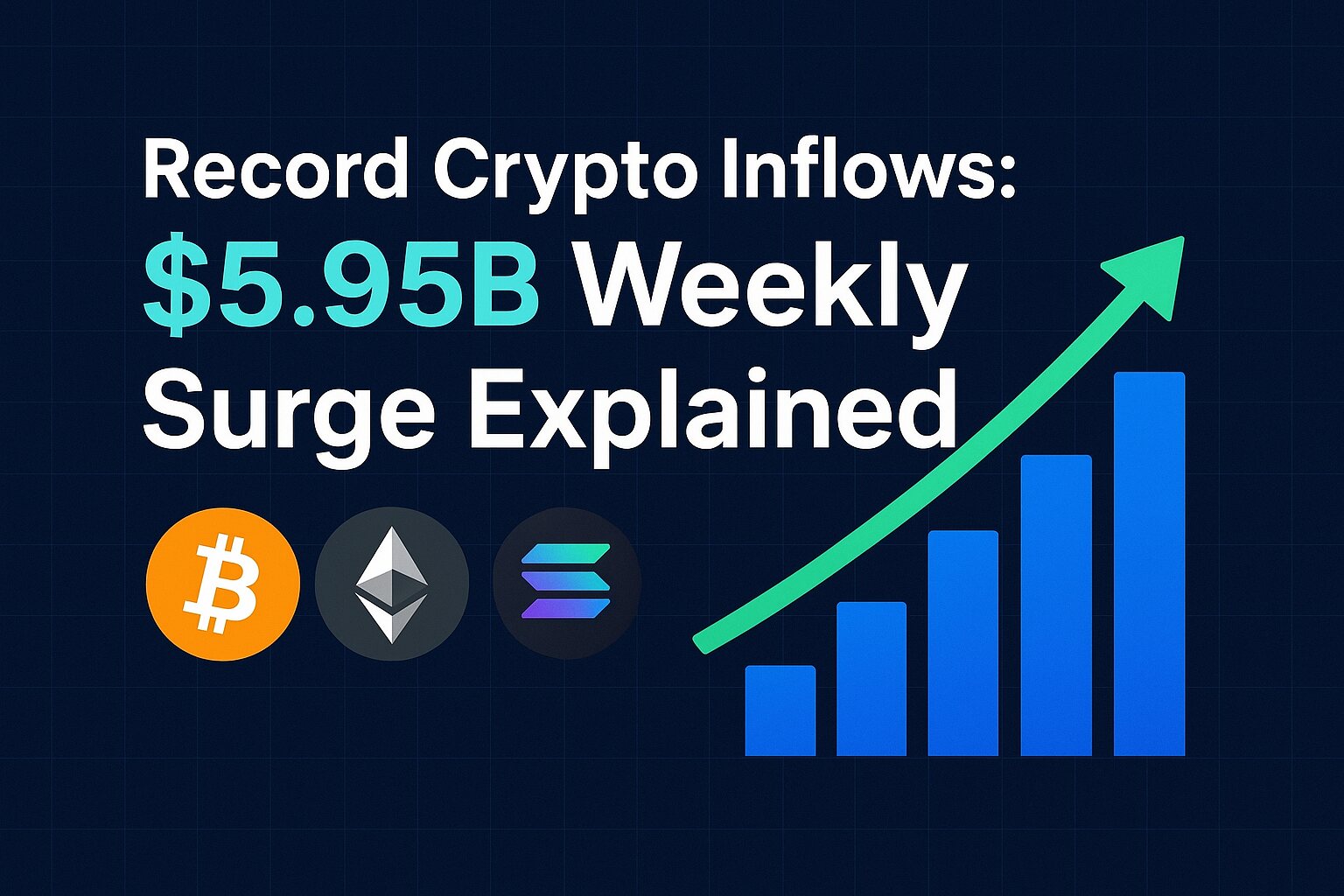
Target keyword present in first paragraph:
The recent record crypto inflows — $5.95 billion into digital asset investment products in a single week — mark a watershed moment for institutional adoption and liquidity dynamics. This article explains what happened, why it happened (macro and political catalysts), and how technical and on-chain indicators align with fund-flow data.
What the data shows: headline numbers and immediate context
Key numbers (week ending early October 2025):
- What the data shows: headline numbers and immediate context
- Macro & political catalysts (the “why”)
- Government shutdown & market psychology
- Weak employment data & delayed rate expectations
- ETF & product mechanics
- On-chain analysis: supply, accumulation, and liquidity
- Technical analysis: price structure and momentum
- Table: Fund flows by asset (weekly snapshot)
- Market-structure implications: cause → effect
- Risks, caveats, and alternative interpretations
- Practical takeaways for traders & site readers
- Final summary & outlook
- Total weekly inflows: $5.95B (record weekly inflow).
- Bitcoin inflows: ~$3.55B, the largest inflow for BTC on record.
- Ethereum inflows: ~$1.48B, pushing YTD ETH fund flows higher.
- Solana, XRP and others: Solana ~$706.5M, XRP ~$219.4M (top altcoin inflows).
- Total AuM after flows: ≈ $254B (digital asset products AUM at new highs).
Why these figures matter: this is the largest single-week institutional demand signal recorded by fund-flow trackers — it directly injects liquidity into spot markets, narrows bid/ask spreads for large trades, and increases the effective market depth for BTC/ETH.
Macro & political catalysts (the “why”)
Government shutdown & market psychology
The U.S. government shutdown created sudden political risk and heightened expectations of looser near-term monetary policy. Investors reacted by rotating into risk assets and digital gold narratives — i.e., Bitcoin and major altcoins — as part of a broader allocation shift.
Weak employment data & delayed rate expectations
Weak ADP / jobs prints during the same period increased the probability of the Fed easing or pausing hikes sooner than expected. Lower real yields favor risk assets; institutional desks and ETF engines re-weighted exposures into crypto ETPs in response.
ETF & product mechanics
Spot Bitcoin and Ethereum ETPs (and other investment products) provide a straightforward flow channel from institutional cash to on-exchange spot supply. When large fund orders hit, they translate into significant buying pressure on spot markets, producing a price feedback loop that can accelerate inflows.
On-chain analysis: supply, accumulation, and liquidity
Short summary (on-chain signals supporting inflows):
- Exchange withdrawals: On-chain metrics show net outflows from major custodial exchanges, consistent with accumulation and ETF custody behavior.
- Whale accumulation: Large addresses and known treasury wallets increased balances in the days leading up to and during the inflow week — a classic sign of durable demand rather than short-term speculation.
- Realized volatility vs. implied: A fall in realized volatility concurrent with rising implied vol and funding-rate normalization suggests market makers are hedging larger directional exposure — consistent with strong spot buy pressure caused by fund flows.
What to watch on-chain (metrics):
- Exchange reserve decline (BTC / ETH).
- New addresses holding >0.1 BTC (accumulation band).
- Stationary or increasing stablecoin supply on exchanges (dry powder) vs. stablecoin conversions into BTC/ETH.
Technical analysis: price structure and momentum
Bitcoin technicals (short-to-medium term)
- Breakouts & volume: Spot BTC broke multi-week resistance on heavy volume coincident with the inflows — a textbook demand shock.
- Moving averages: Price trading above major moving averages (50/100/200 EMAs) signals trend confirmation; look for pullbacks to MA confluence as buy zones.
- RSI & MACD: Short-term RSI moved into overbought territory after the inflow week — caution for immediate mean reversion, but MACD cross confirms medium-term momentum.
Ethereum technicals
- Rotation from BTC to ETH: The sizeable ETH inflow suggests an ongoing rotation; ETH often lags BTC in early bull phases but shows faster relative strength once DeFi/real-yield narratives accelerate.
- Support levels: Identify prior consolidation zones as potential support for ETH on pullbacks.
Table: Fund flows by asset (weekly snapshot)
| Asset | Weekly Inflows (approx.) | Notes |
|---|---|---|
| Bitcoin (BTC) | $3.55B | Largest weekly BTC inflow on record. |
| Ethereum (ETH) | $1.48B | Significant institutional ETH demand; YTD flows increasing. |
| Solana (SOL) | $706.5M | Strong altcoin allocation; liquidity concentrated in top chains. |
| XRP | $219.4M | Renewed institutional interest. |
| Total (digital asset products) | $5.95B | Record weekly inflow; AuM ~ $254B. |
Market-structure implications: cause → effect
Cause: Political instability (shutdown) + weaker macro prints + ETF/equity mechanics → Effect: Rapid rerouting of institutional cash into crypto ETPs.
Chain reaction explained:
- Macro shock increases risk premium on USD assets or alters rate expectations.
- Institutional allocators re-assess portfolios, increasing allocations to alternative stores of value and return-seeking assets.
- Fund flows into spot ETPs convert cash into large market buy orders.
- Spot price rises; technical breakouts attract momentum traders, increasing liquidity and further inflows.
- On-chain reserves drop (custody increases), reducing immediately available sell pressure and causing tighter markets.
Risks, caveats, and alternative interpretations
- Flow sustainability: One large week does not equal permanent capital — monitor if inflows persist across multiple consecutive weeks.
- Catalyst reversals: If the political situation resolves or macro prints surprise to the upside, flows could reverse quickly.
- Market concentration: Heavy flows into BTC/ETH increase systemic coupling; altcoins may decouple if liquidity rotates out.
- Liquidity risk on rebalancing days: Rapid inflows can widen spreads when funds attempt to rebalance, making execution costly for retail traders.
Practical takeaways for traders & site readers
- For swing traders: Use technical zones identified above; expect volatility after big flow weeks and set clear risk controls.
- For investors: Track weekly fund-flow reports as a leading indicator of institutional behavior. Record crypto inflows weeks are important signals, but dollar-cost averaging remains prudent.
- For analysts: Combine fund-flow data with on-chain metrics (exchange reserves, whale wallets) to separate sustainable accumulation from fleeting momentum.
Final summary & outlook
Institutional demand — channeled via exchange-traded and other investment products — drove a record $5.95B inflow in a single week, concentrated in Bitcoin and Ethereum and supported by macro/political catalysts including a U.S. government shutdown and weak labour data. On-chain signals and technical indicators generally corroborate accumulation, but sustainability depends on whether inflows continue beyond a one-off defensive allocation.
Conclusion: This is a major validation signal for institutional market participation — monitor subsequent weekly flow reports and on-chain metrics for confirmation. Not financial advice.





